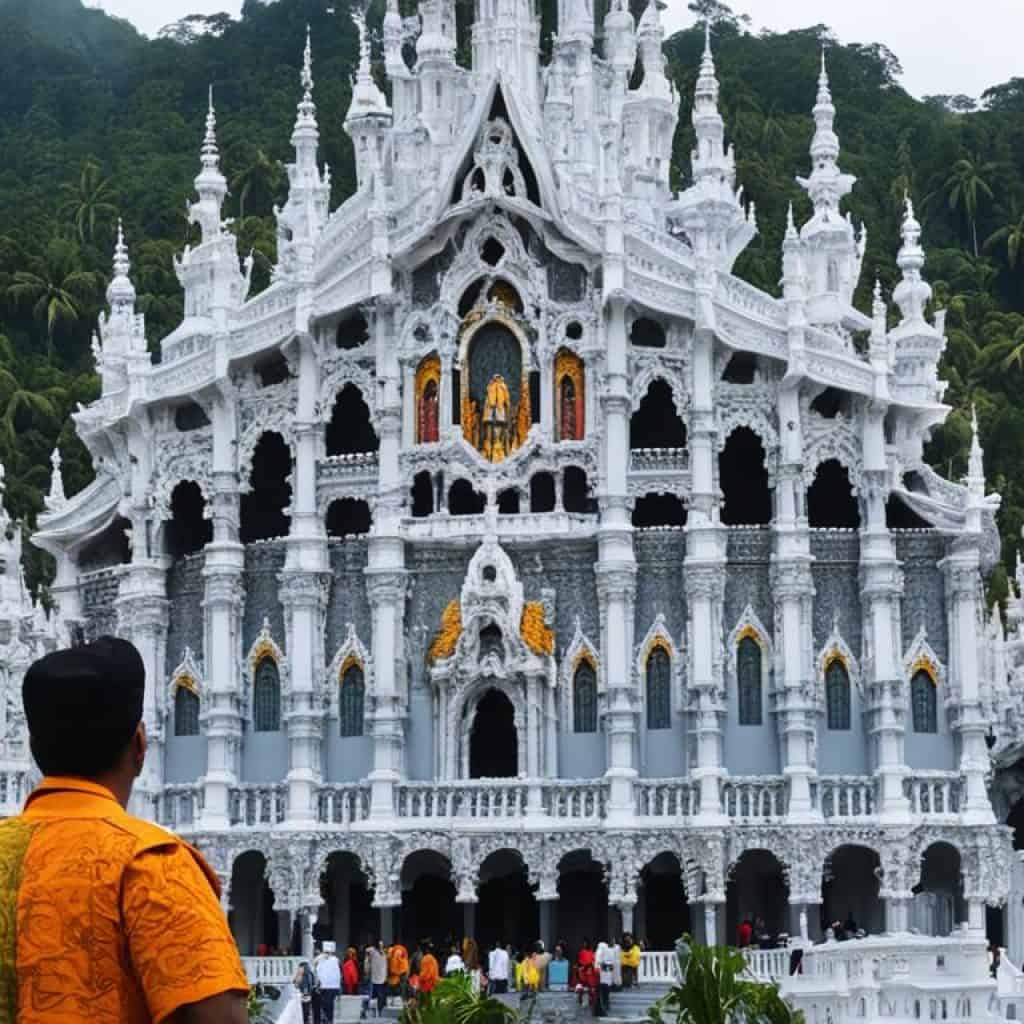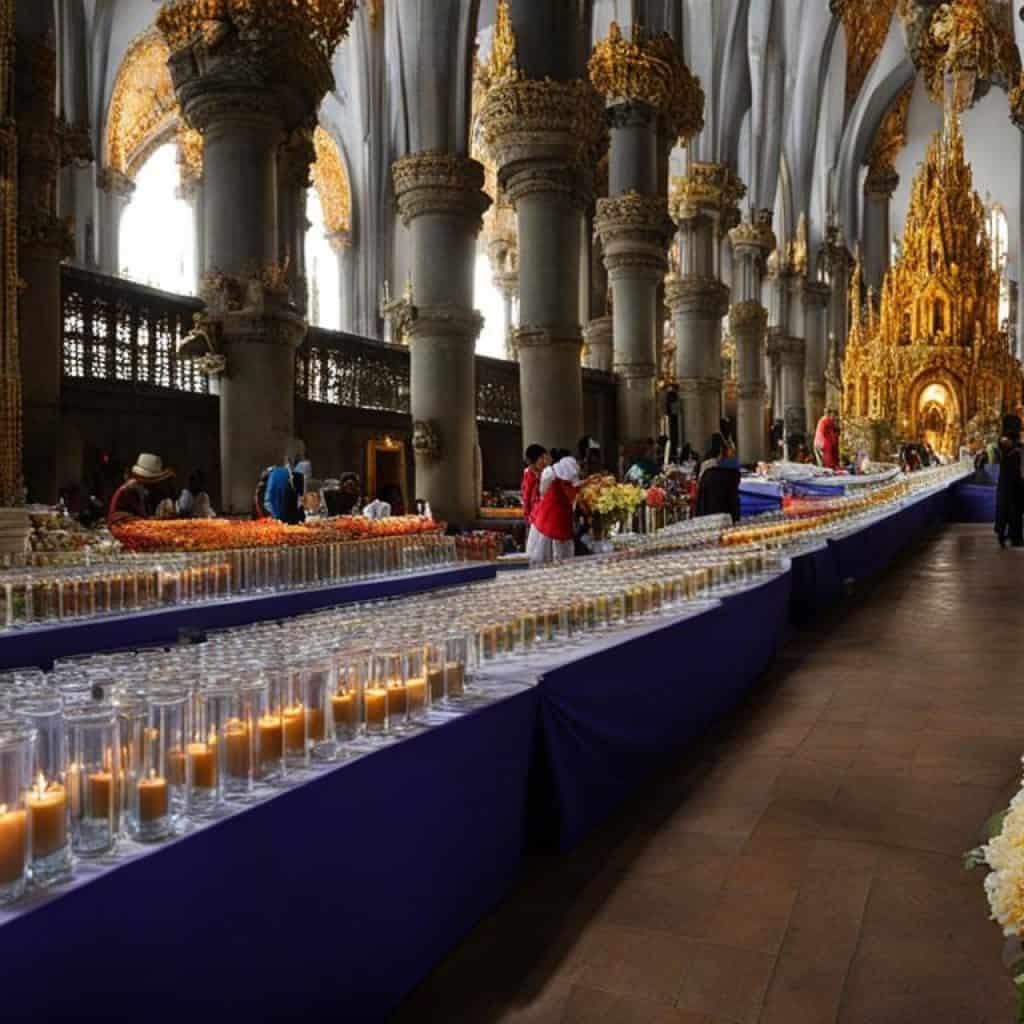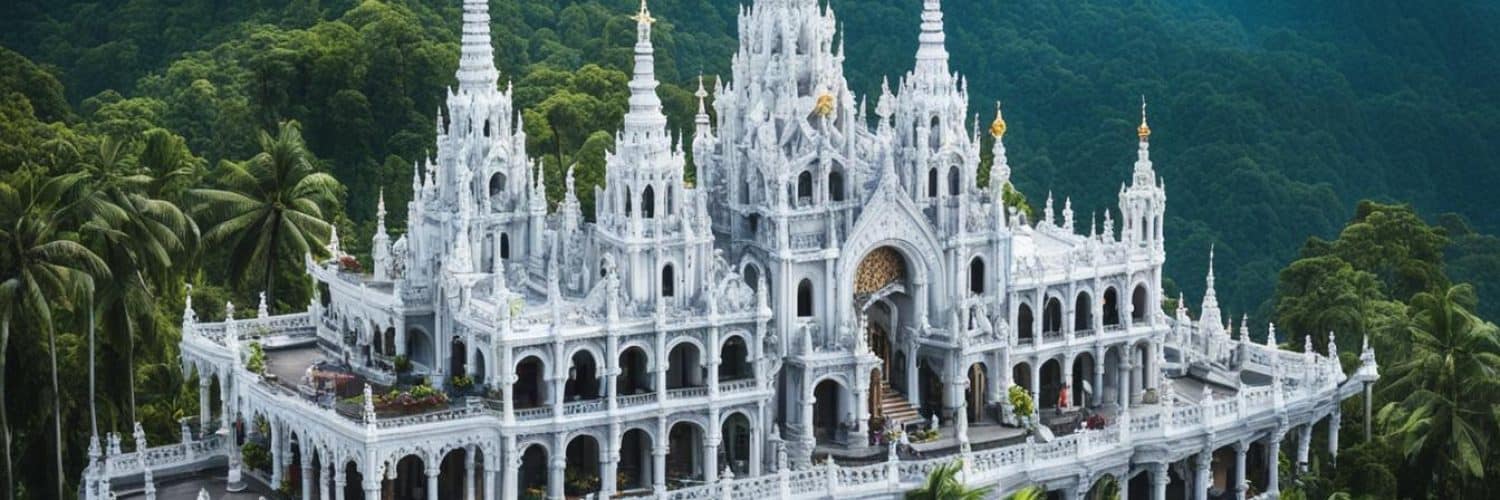Stepping into the heart of religious tourism in the Philippines, the esteemed Simala Church beckons devout travelers and curious visitors alike to the quiet municipality of Sibonga, located in the southern part of Cebu Philippines. This church, a revered pilgrimage destination, stands out not merely for its spiritual significance but also as an architectural gem representative of contemporary religious ardor.
Attracting throngs of people year-round, Simala Church extends beyond a haven of worship; it’s an emblem of hope, where many claim to have witnessed the miraculous. Whether you’re on a soul-searching journey or exploring the many facets of Cebu’s rich cultural landscape, this destination demands a visit, promising an experience that will touch the very core of your being.
Key Takeaways
- Discover the spiritual allure of Simala Church, a place of pilgrimage and wonder.
- Experience both the cultural and religious tapestry that Simala Church weaves into Sibonga.
- Immerse yourself in the architectural splendor and tranquil grounds of the church in the heart of Cebu Philippines.
- Learn the profound impact of religious tourism at a site steeped in miracles and devotional stories.
- Prepare for a transformative visit to a destination that transcends the boundaries of mere sightseeing.
Welcome to the Majestic Simala Church
The Simala Church, nestled in the serene town of Sibonga, Cebu Philippines, is not only a testament to Simala Church history, but also a symbol of profound religious significance. As a well-established pilgrimage site, its origins are deeply connected with the faith-driven acts of the Marian Monks of Eucharistic Adoration. Today, the church stands tall, drawing countless devotees and visitors who come to experience its serene ambiance and spiritual grace.
The History and Significance of this Religious Site
Marking its spiritual journey, a pivotal event unfolded in 1998 when a replica statue of the Virgin Mary within the church was seen weeping, an occurrence that captured the hearts of many and marked the shrine’s revered status. Governed by the Marian Monks of Eucharistic Adoration, who have a storied history of healing and faith, Simala Church has become entrenched in stories of miracles, including the miraculous recovery of dengue fever sufferers.
Architectural Splendor of the Simala Shrine
The Simala Shrine is a marvel of religious architecture. Its architectural beauty is often likened to a grand castle, complete with elaborate façades and elegant turrets. The grounds of the shrine feature beautifully landscaped gardens, which complement the intricate design of arched corridors and domed ceilings. The aesthetic charm of the site continues to evolve, all while nurturing the spirituality of those who visit.
Here’s a glimpse of the architectural highlights that make the Simala Shrine a destination of beauty and faith:
| Architectural Feature | Description | Religious Significance |
|---|---|---|
| Grand Facade | Resembling a castle with ornate details | A metaphor for the fortitude and majesty of faith |
| Arched Corridors | Elegantly curved pathways inviting contemplation | Symbolize the journey of life and faith |
| Domed Ceiling | Sweeping domes that reach towards the heavens | Represent the encompassing embrace of the divine |
| Landscaped Gardens | Carefully manicured verdant spaces | Reflect the order and beauty of creation |
It’s the careful blend of purpose, faith, and aesthetics that gives the Simala Church in Sibonga its unique charm, beckoning to those seeking solace and those appreciating the magnificence of religious architecture. Indeed, each visit to this sacred site unveils layers of history and artistry, enshrining it in the hearts of its visitors as a place of devotion and splendor.
Exploring the Miraculous Simala Church, Sibonga, Cebu Philippines
The reverence for the Virgin Mary takes a tangible form at the Simala Church, a sanctuary deeply rooted in miraculous sightings and divine presence. Situated in the heart of Sibonga in Cebu, Philippines, the Simala Church stands as a beacon of hope for those who seek spiritual fulfillment and a testament to the sacred.
The pilgrimage to Simala Church is as much about the journey as it is the destination. Visitors arrive with stories, prayers, and a longing to experience the mystical aura that defines this holy place. The Virgin Mary’s weeping statue serves as a powerful symbol of the church’s miraculous reputation, stirring the faith of believers and skeptics alike.
Embarking on Simala Church exploration involves more than walking through its imposing structure; it is an opportunity to witness faith and devotion firsthand. Pilgrims and tourists are drawn to Simala not just to see but to feel the palpable energy of a site that has been touched by the divine.
Every corner of Simala Church whispers tales of the miraculous, urging visitors to pause, reflect, and connect with the divine spirit believed to preside over this sacred place.
The church’s architecture, grand in its scope and design, mirrors the monumental depth of the faith that countless devotees have invested in this place. From the distant view of its castle-like stance against Sibonga’s serene backdrop to the intricate details carved into its altars and pillars, Simala Church hosts a rich visual narrative of conviction and miracles.
Whether one attends a heartfelt mass or walks in solitude among the pews where so many have sought and found comfort, a visit to Simala Church is undeniably transformative. It holds the promise of spiritual discovery and a momentary commune with the extraordinary, reinforcing the profound place the Virgin Mary holds in the hearts of believers throughout Cebu and beyond.
A Simala Church exploration is not just about exploring the physical space but also delving into the intangible essence that makes the church a cornerstone of belief in miraculous events. The emotional imprints left by visitors who claim their lives were changed within these walls linger, inviting others to explore what makes Simala Church a remarkable place of reverence.
A Pilgrim’s Guide to Simala Church

Embarking on a spiritual journey to Simala Church in Sibonga requires an understanding of the customs and expectations that govern this holy place. To enrich your visit with respect and reverence, familiarize yourself with the guidelines for proper attire and conduct at this revered site.
Dress Code and Visitor Etiquette
Respecting the dress code at Simala Church is crucial for all who come to seek blessings or simply admire its sanctity. The community of Sibonga holds sacred etiquette in high regard, and as a visitor, adherence to these norms is expected. Below is a checklist to ensure your attire aligns with the dress code:
- Skirts and shorts should be knee-length or longer.
- Sleeveless shirts, halter tops, and tank tops are to be avoided.
- Avoid wearing any see-through clothing or tops showing the midriff.
- Tight-fitting or provocative attire is not permitted.
- Hats or caps should be removed upon entering the church as a sign of respect.
By adhering to these clothing guidelines, Simala Church visitors not only show respect for the religious site but also engage in religious behavior befitting such a sacred space.
How to Behave: Respectful Conduct Within the Church
When inside the church and its grounds, your actions must mirror your respect for the religious practices and worship happening around you. For those unfamiliar with local customs, here’s what is expected:
- Maintain silence or speak softly to preserve the church’s atmosphere of prayer.
- Switch off or set phones to silent mode to avoid disrupting services or meditation.
- Respect areas marked for prayer by engaging in silent contemplation or joining in prayer.
- Refrain from eating, drinking, or smoking on church property.
- Photography should be conducted without flash and in a manner that does not disturb others.
Your observance of these principles echoes the respectful conduct and sacred etiquette that encapsulates the spirit of Simala Church, allowing you and fellow pilgrims to experience the profound religious respect that pervades the site.
| Aspect of Visit | Recommendations for Respectful Conduct |
|---|---|
| Attire | Modest clothing reflecting the solemnity of Simala Church |
| Photography | Allowed but without flash; must not disturb the sanctity of services |
| General Behavior | Quiet and reverent, reflecting the nature of religious behavior |
| Cell Phone Use | Always silent mode; respectful conduct includes minimizing digital distractions |
This guidance serves not only as a Simala Church guide but also invites reflection on the broader implications of being a respectful participant in spaces that hold deep spiritual significance for the community of Sibonga and beyond. Embracing this guidance ensures an experience that is both personally enriching and communally harmonious.
The Miraculous Sightings and Healing Powers of Virgin Mary
For many believers, Simala Church is more than a mere structure; it’s a testament to the miraculous sightings and healing powers associated with the Virgin Mary. Pilgrims from various regions flock to this holy sanctuary, their faith strengthened by stories of the Virgin Mary’s interventions, manifesting in events beyond human reasoning.
One of the cornerstones of Simala Church’s legend is the reported phenomenon of the Virgin Mary’s statue shedding tears of blood. This occurrence is not alone; the church’s prayer room houses a myriad of accounts detailing inexplicable recoveries and prayers answered—each narrative contributing to the church’s aura of mysticism and spirituality.
The fragrance of fresh flowers within the church premises is said to hold its own wonder, reputedly having the power to aid in the healing of illnesses like dengue fever. These stories are not just passed down as folklore—they are shared by those who claim to have experienced these wonders firsthand, affirming Simala Church as a beacon of hope for many in search of divine intervention in their time of need.
Below you will find a table which compiles some of the most talked-about miracles attributed to the Virgin Mary at Simala Church:
| Miraculous Event | Impacted Individuals | Description of Outcome |
|---|---|---|
| Weeping Statue | General Public | Increased faith and pilgrimages to Simala Church |
| Fragrance of Flowers | Illness-Afflicted Individuals | Reports of improved health following visits |
| Answered Prayers | Devotees | Personal testimonies of life changes and blessings received |
Devotees often recount their transformative experiences at Simala Church with deep personal conviction, many having inscribed their gratitude on plaques and letters left within the walls of the church. This sacred ground continues to stand firm in its promise of solace and sanctity, making each visit an encounter with the divine—where the veil between heaven and earth seems ever so thin.
What to See at Simala Church: Religious Art and Icons
As you step inside the revered Simala Church in Sibonga, you are immediately greeted by an astounding array of religious art and icons that speak to the devout spirit thriving within its walls. Notably, the Crying Virgin Mary statue captivates both pilgrims and art enthusiasts alike. The poignant image, surrounded by tales of miraculous weeping, beckons a closer look, promising an encounter with the transcendent.
The Crying Virgin Mary Statue
At the heart of the Simala Church icons lies the mystifying Crying Virgin Mary statue. It stands as a profound symbol of faith—a steadfast witness to countless pilgrimage visits, drawing those in search of solace and spiritual connection within the church’s sacred space. This statue is not only an emblem of divine manifestation but also a masterpiece of religious art, echoing the deep reverence and admiration for the Blessed Mother.
Bearing witness to this miraculous figure offers an intimate moment of reflection, inviting visitors to be part of the narrative of faith that Simala Church embodies. This encounter is often a pinnacle moment for many who travel to this sanctuary, hoping to glean even a fragment of the divine grace attributed to this cherished icon.
Exploring the Church’s Interior: Altar and Domes
The Simala Church interior unfolds a visual narrative through its elaborate altars and sweeping domed ceilings. Inundated with celestial frescoes and an array of religious artifacts, every corner of the prominent altar space whispers stories of devotion and artistry. The church’s formidable architecture invites visitors to cast their gazes upward, where they encounter a vast canvas of biblical tales and saintly images, encouraging a moment of upward contemplation.
- The altar, incessantly improved and adorned, is a central focus for prayer and veneration.
- Rich with ornate imagery, the domes offer an immersion in both aesthetic beauty and religious significance.
The Simala Church’s interior serves not just as a house of worship but as a spiritual gallery where art and faith converge in a harmonious symphony. Every element, from the gracefully painted alcoves to the serenely posed statues, forms a cohesive realm where the subtleties of sacred art render the space hallowed.
Whether you’re in Sibonga for a pilgrimage or merely to marvel at the infusion of art within a place of worship, Simala Church offers a serene and inspiring atmosphere. With its grandiose interior and spiritually charged icons, it stands as a beacon of religious heritage, awaiting all who wish to delve into the cultural and divine narratives it encapsulates.
Experience Physical and Spiritual Nourishment
The splendor of Simala Church extends beyond its prayer halls to a realm of tranquil serenity. As visitors wander the grounds, the meticulously arranged Simala Church gardens and the gentle murmurs of a fountain underscore the church’s dedication to fostering an environment of spiritual nourishment.
Despite the fountain’s intermittent activity, the sanctuary landscape—with its carefully curated greenery—translates the community’s reverence into living art. The congregation’s adoration is made tangible through floral tributes and natural elements that align to utter “We Love Mama Mary,” combining devotion with nature’s own aesthetics.
The Landscaped Gardens and Fountain
The Simala Church gardens, a haven within a haven, stand as a testament to the church’s holistic approach to rejuvenation—mind, body, and soul. The soft cascade of the fountain’s waters provides visitors with a sonic backdrop for contemplation, homage, and perhaps, personal epiphanies.
The Prayer Hall of Gratitude and Healing
The heart of emotional and spiritual solace within Simala Church manifests in the Prayer Hall. Visitors are met with powerful visual testimonials of faith that line the walls—each item, whether it be a pair of crutches or a heartfelt letter, conveying stories of gratitude and healing miracles. In this space, tales of transformation and divine grace are chronicled through personal tokens of those who experienced a touch of the miraculous.
| Visitors’ Offerings | Meaning | Impact |
|---|---|---|
| Crutches and Wheelchairs | Physical healings | Manifested miracles |
| Letters of Thanks | Expressing gratitude for answered prayers | Emotional connection with the divine |
| Drawings and Personal Items | Devotion and the journey of faith | Inspiration to visiting believers |
In conclusion, the Simala Church prayer hall and its adjacent outdoor spaces form a sanctuary where stories of humanity intertwine with the spiritual, presenting pilgrims and visitors alike with an opportunity for reflection, renewal, and profound appreciation.
The Colorful Tradition of Candle Lighting
At the heart of Simala Church tradition is the vivid and meaningful practice of candle lighting. This symbolic act, deeply ingrained within the Filipino religious culture, transcends the simple act of igniting wax. It is a visual prayer where each flickering flame represents a heartfelt wish or a devout supplication made by visitors from all over the world.
Understanding the color significance in this vibrant ritual is essential for those who wish to participate meaningfully in this Simala Church practice. Each hue is selected with intention, echoing the innermost desires and hopes of the faithful. Embraced by the solemn ambiance where silence speaks volumes, the kaleidoscope of prayer candles casts a warm glow, paving the way for petitions and gratitude to ascend.
The Significance of Different Candle Colors
For many visitors, selecting the right candle is an integral part of the prayer process. The myriad of colors serve as a spiritual lexicon, translating personal intentions into the universal language of light. Below is a comprehensive table detailing the color significance associated with the Simala Church tradition:
| Color | Intention |
|---|---|
| White | Guidance and purity |
| Blue | Perseverance and peace |
| Green | Prosperity and success |
| Gold | Healing and recovery |
| Red | Passion and love |
| Pink | Thanksgiving and joy |
| Purple | Achievement and wisdom |
| Brown | Development and nurturing |
| Black | Prayers for the departed |
The tradition of candle lighting holds a special place for those who come to Simala Church seeking solace, hope, and the tangible presence of their faith. The act of lighting a prayer candle is not just a momentary gesture; it is a lasting emblem of wishes set aflame, conveying a powerful message of belief and trust to the divine.
Engaging with the Local Faith Community
At the heart of the Philippines’ religious tourism, Simala Church offers a unique opportunity to immerse oneself in the vibrant Filipino Catholic culture. This distinguished shrine serves not only as a sanctuary of spirituality but also as a hub where the engaging faith community warmly welcomes visitors, inviting them to partake in traditional practices and religious observances that are integral to the local social fabric.
Religious Tourism: Embracing Filipino Catholic Faith and Culture
When visitors set foot in the peaceful town of Sibonga, they step into a landscape of devotion and cultural richness. Simala Church, with its open doors and majestic structure, draws not only those in search of miracles but also individuals keen on experiencing and understanding the deep-rooted faith that pulsates throughout the Filipino community. The following table provides insights into the various activities that enable tourists to engage with the religious atmosphere at this sacred destination:
| Activity | Description | Cultural Significance |
|---|---|---|
| Mass Attendance | Participate in holy Mass, held multiple times throughout the week. | Experiencing the communal prayer underscores the significance of worship in Filipino life. |
| Candle Lighting Ritual | Light candles for various intentions as part of a widespread spiritual practice. | Reflects the multifaceted aspects of locals’ prayer life and their belief in the power of intercession. |
| Prayer and Veneration | Engage in personal prayer or venerate the statues and icons within the church. | Illustrates the personal and emotional connection between the faithful and the divine. |
| Community Interaction | Connect with locals, religious figures, and fellow pilgrims. | Encourages understanding and integration into the local community’s way of life. |
For those looking to delve deeper into the religious facets of Simala Church, interacting with members of the faith community can be particularly enlightening. Conversations with locals may lead to stories of personal miracles, insights into the significance of the church, and an understanding of cultural traditions that are an inseparable part of their identity.
Engaging with the local faith community not only augments visitors’ religious tourism experience but also fosters a greater appreciation for the Filipino Catholic culture that thrives around Simala Church.
Preparing for Your Visit to Simala Church
Embarking on a spiritual journey to Simala Church requires thoughtful visit preparation to ensure an enriching and reflective experience. Whether seeking the peace of Simala Church solitude or intending to participate in the sacred Mass, adhering to the best visit times is essential. For those journeying through the pilgrimage route and utilizing Cebu transportation options from various starting points like Moalboal travel, understanding Simala Shrine directions is key to a smooth pilgrimage.

Best Times to Visit for Solitude or Mass
For those longing for moments of solitude within the sacred walls of Simala Church, weekday mornings provide an ideal atmosphere. Visiting right after the church opens at 6 am can offer a more serene ambiance. The Mass schedule is accommodating, with daily services as well as special Masses conducted on the 13th of each month. These are the times when the spiritual vibrancy of the church is most palpable.
Directions: Getting to Simala Shrine from Moalboal
Travelers departing from Moalboal can anticipate a scenic route toward Simala Shrine, with landmarks peppered along the way to enhance their Cebu journey. The following table provides a simple guide on Moalboal travel towards Simala Church, complete with Cebu transportation tips and a recommended place of stay to ensure a tranquil retreat before or after your pilgrimage.
| Starting Point | Route | Notable Attractions | Estimated Travel Time | Accommodation Highlight |
|---|---|---|---|---|
| Moalboal | Ronda ➔ Ylaya Road to Argao | Lusno Falls | 2 hours | Moalboal Eco Lodge |
| Navigate to ‘Simala Parish Church’ on your offline map for ease of travel. | ||||
Conclusion
In summing up the essence of Simala Church, it’s clear that it vastly surpasses the mere expectations of it as a tourist destination. The church stands as an indelible spiritual stronghold amidst the verdant landscapes of Cebu, offering a pilgrimage that resonates with the hearts of many. From its awe-inspiring architecture to the palpable sense of the divine, Simala Church is a bastion of hope and faith for both the local community and travelers alike.
Why Simala Church Is More Than Just a Tourist Attraction
The profound experiences that unfold within and beyond the walls of Simala Church underscore its significance. To step inside is to be enveloped in a narrative that is both ancient and unfolding – a tapestry woven with threads of spiritual encounters, miraculous healings, and a sense of belonging for devotees. By engaging with this sacred space, one becomes part of a continuum of belief that not only stretches back through history but also reaches forward, touching lives with stories of faith and miracles.
Conclusively, Simala Church is an emblem that captures the true spirit of a Cebu pilgrimage. The church, with its grandiose façade and intimate altars, serves as a physical representation and testament to the power of faith. It beckons beyond tourism, inviting a deeper, more intimate exploration of one’s spirituality. In the stillness of its halls or the vibrant community surrounding it, visitors discover more than just a place; they uncover a journey into the heart of devotion.
FAQ
What is the history of Simala Church?
Simala Church, also known as the Monastery of the Holy Eucharist, was established by the Marian Monks of Eucharistic Adoration in 1998 after a miraculous sighting of a statue of Virgin Mary weeping tears of blood. It is located in Sibonga, Cebu Philippines, and has become an important pilgrimage destination for believers seeking miracles and healing from the Virgin Mary.
Can you describe the architectural style of Simala Church?
The Simala Shrine exhibits a grandeur reminiscent of a castle, with turrets, arched corridors, and a domed ceiling, combining religious architecture with aesthetic beauty. Its design continues to evolve, attracting visitors not just with its spiritual significance but also with its architectural splendor.
Are there any restrictions on attire for visiting Simala Church?
Yes, Simala Church enforces a strict dress code. Visitors are required to dress modestly, avoiding short skirts, shorts above the knee, sleeveless tops, backless dresses, transparent clothing, and tight or provocative outfits, to uphold the sacredness of the religious site.
What are some of the miraculous sightings reported at Simala Church?
Simala Church is known for several miraculous events, including the Virgin Mary statue reportedly weeping blood, as well as numerous accounts of devotees experiencing healing and having their prayers answered. These events contribute to the church’s reputation as a site of divine intervention.
What religious art and icons can be seen at Simala Church?
Visitors to Simala Church can view an array of religious art and icons including the central image of the weeping Virgin Mary statue. The church’s interior is also adorned with vibrant frescoes on its domed ceiling and a beautifully designed altar that adds to the spiritual atmosphere of the sanctuary.
What does the candle lighting tradition at Simala Church symbolize?
Candle lighting at Simala Church is a tradition where different colors represent various prayer intentions. For instance, white symbolizes guidance, black is for the souls of the departed, gold for healing, green for prosperity, and red for love, allowing pilgrims to express their specific prayers and intentions.
How can visitors engage with the local faith community at Simala Church?
Visitors are encouraged to participate in the religious activities, attend Mass, and immerse themselves in the Filipino Catholic faith and culture during their time at Simala Church. It’s an opportunity to experience the deep spiritual connection of the local community and understand their devotion practices.
When is the best time to visit Simala Church for a tranquil experience?
To enjoy a more peaceful visit, it is recommended to go to Simala Church on weekdays, preferably early in the morning right after it opens at 6 am. Masses are held daily, with extra services on the 13th of each month, affording various opportunities to witness and participate in the church’s spiritual life.
How do I get to Simala Church from Moalboal?
Why is Simala Church considered more than just a tourist attraction?
Simala Church is a spiritual stronghold deeply ingrained in the faith of its worshippers. With its history of miraculous sightings and the profound impact it has on the lives of the faithful, it transcends being a mere tourist spot, serving as a significant emblem of Catholic devotion in Cebu.











Add comment